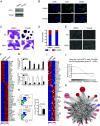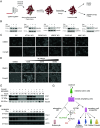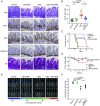Therapeutic targeting of the NOTCH1 and neddylation pathways in T cell acute lymphoblastic leukemia
- PMID: 40163723
- PMCID: PMC12002235
- DOI: 10.1073/pnas.2426742122
Therapeutic targeting of the NOTCH1 and neddylation pathways in T cell acute lymphoblastic leukemia
Abstract
Gamma Secretase Inhibitors (GSIs) effectively block oncogenic Notch homolog-1 (NOTCH1), a characteristic feature of T cell acute lymphoblastic leukemias (T-ALL). However, their clinical application has been stalled by the induction of severe gastrointestinal toxicity resulting from the inhibition of NOTCH signaling in the gut, which translates into increased goblet cell differentiation. Genome-wide CRISPR loss-of-function screen in the colon cancer cell line LS174T identified the neddylation pathway as a main regulator of goblet cell differentiation upon NOTCH1 inhibition. Consistently, pharmacologic inhibition of the neddylation pathway with the small molecule inhibitor MLN4924, rescued GSI-induced differentiation in LS174T cells. Mechanistically, neddylation inhibition by MLN4924 increases the protein stability of Hairy and enhancer of split-1, a direct NOTCH1 transcriptional target and key regulator of absorptive and secretory cell fate decisions. Combined treatment with GSI and MLN4924 in a murine Notch1-dependent model of T-ALL led to leukemia regression and improved overall survival in the absence of gut toxicity. Overall, these results support the combined targeting of the NOTCH1 and neddylation pathways for the treatment of NOTCH1-induced T-ALL.
Keywords: HES1; NOTCH1; T cell lymphoblastic leukemia (T-ALL); experimental therapeutics; neddylation.
Conflict of interest statement
Competing interests statement:P.P.-D. is currently employed by Revvity, Waterbeach, United Kingdom; A.A.-I. is currently employed at PsychoGenics Inc., Paramus, NJ; J.S. is currently employed by Bristol Myers Squibb, Lawrenceville, NJ; A.F. is currently employed by Regeneron Pharmaceuticals, Tarrytown, NY. None of the data presented in this manuscript is in any way related to their current activities.
Figures




References
-
- Sutton R., et al. , Persistent MRD before and after allogeneic BMT predicts relapse in children with acute lymphoblastic leukaemia. Br. J. Haematol. 168, 395–404 (2015). - PubMed
-
- Weng A. P., et al. , Activating mutations of NOTCH1 in human T cell acute lymphoblastic leukemia. Science 306, 269–271 (2004). - PubMed
MeSH terms
Substances
Grants and funding
LinkOut - more resources
Full Text Sources
Medical

